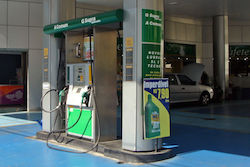According to a recent report published in Nature Geoscience, when drivers in Sao Paulo switched from ethanol to pure gasoline, there was a 20 percent reduction in local ozone levels in urban areas. However, all gasoline in Brazil is blended with ethanol and upon further review, the report actually showed that using med-level ethanol blends (E25) ozone levels improved.
Steve Vander Griend, with Urban Air Initiative, explained how this is the case. Unlike in the United States, Brazil has two legal fuels: E25 (25 percent ethanol and 75 percent gasoline) and E100 (95 percent ethanol and 5 percent water), better known as hydrous ethanol. Nearly all vehicles sold in Brazil are flex fuel and can use any ethanol blend. Under Brazil’s model, drivers can “choose” their blend of ethanol from E25 up to E100 based on price.
Vander Griend explained that ozone emissions are highest with pure gasoline and also hydrous ethanol. However, emissions are reduced when you add ethanol to gasoline, aka a mid-level ethanol blend such as E15 or E30, blends sold in the U.S. This is why this study found that Brazil saw ozone emissions improve when drivers started using E25 instead of hydrous ethanol (E100). Therefore, said Vander Griend, the notable results of this study are that mid-level ethanol blends do in fact improve ozone emissions.
 With 70 percent of Brazilian fuel being E25 during the time frame of this study, the study actually demonstrated Brazil has one of the cleanest burning fuels available, continued Vander Griend, and it also highlighted the value of mid-level ethanol blends.
With 70 percent of Brazilian fuel being E25 during the time frame of this study, the study actually demonstrated Brazil has one of the cleanest burning fuels available, continued Vander Griend, and it also highlighted the value of mid-level ethanol blends.
So why are people being led to believe that ethanol is harmful to the environment? Vander Griend said because you can’t buy pure gasoline in Brazil, when authors refer to gasoline they are really referring to E25 making it appear that the authors studied pure gasoline versus ethanol and this is not the case. With reporters and others not digging into and understanding the study, they are ultimately mis-reporting the facts of the study, added Vander Griend.
The bottom line, said Vander Griend, is that mid-level blends of ethanol have been proven to decrease emissions, and if the U.S. is serious about taking the necessary steps to reduce harmful emissions, it is time that mid-level ethanol blends are offered to consumers.
“Not only will consumers benefit from the availability of a choice and savings at the pump, but when they choose the less expensive, homegrown fuel, they will also be decreasing harmful emissions that are detrimental to our children and future generations,” Vander Griend concluded.

